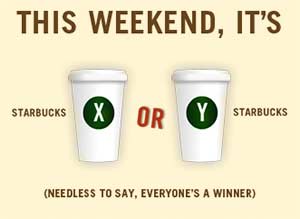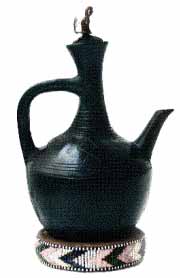 Okay this is the obligatory coffee house post. Starbucks is betting its customers can’t tell fresh brewed from instant. Choose X or Y — the two are separated by gender apparently. Results could prove V, their space-age “VIA” instant product improves on Folgers, or W, their customers can’t tell good coffee from WORSE. I tried it.
Okay this is the obligatory coffee house post. Starbucks is betting its customers can’t tell fresh brewed from instant. Choose X or Y — the two are separated by gender apparently. Results could prove V, their space-age “VIA” instant product improves on Folgers, or W, their customers can’t tell good coffee from WORSE. I tried it.
Starbucks gave itself a break by putting its VIA instant, specially priced at $2.99 for three doses, against its ordinary brew, no Sidamo or Yirgacheffe for comparison. It’s probably the base they have stewing on the BUNN to caffeinate all their products. I couldn’t tell that from truck stop coffee. Good luck differentiating from that.
If Starbucks has set out to prove what Folgers never could, it’s proved what we already suspected. Starbucks has a lock on the best beans in the world, but its customers have been gorging themselves on the caramel whipped creme milkshakes and no longer know espresso from chocolate syrup. VIA will remind them of what coffee used to taste like at Duncan Doughnuts or the Waffle House. Bitter Americana.

 Want an afficionado’s tip? The mother of all coffees is Ethiopian Harrar. Literally. The insight is as olfactory as it is scientific. History records that the first coffees were cultivated in Ethiopia/ Abyssinia on the Red Sea. Every current variety of Coffea Arabica is believed to have originated from those plants. Colombian Juan Valdez picks coffee beans introduced to the New World by the Spaniards. Indoneasian javas were planted by the Dutch. Each of those famous varieties were transplanted Arabica. Starbucks wants to
Want an afficionado’s tip? The mother of all coffees is Ethiopian Harrar. Literally. The insight is as olfactory as it is scientific. History records that the first coffees were cultivated in Ethiopia/ Abyssinia on the Red Sea. Every current variety of Coffea Arabica is believed to have originated from those plants. Colombian Juan Valdez picks coffee beans introduced to the New World by the Spaniards. Indoneasian javas were planted by the Dutch. Each of those famous varieties were transplanted Arabica. Starbucks wants to  Starbucks
Starbucks